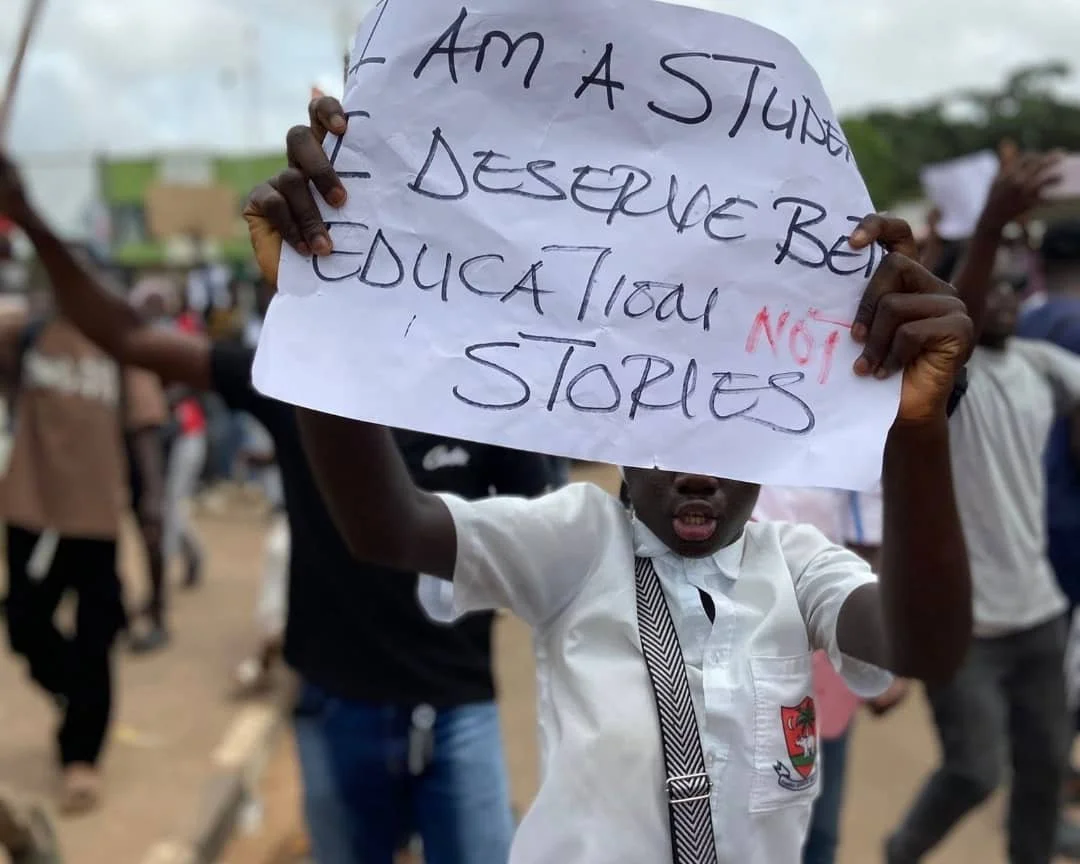“School Uniforms Should Remain a Symbol of Learning, Not for Welcoming President or Joining Protest,” says April 2000 Survivor
Sainey Senghore with the Mic © Askanwi
By Edward Francis Dalliah
Mr Sainey Senghore, a survivor of the April 10/11, 2000 protest, has voiced concerns that school uniforms should be a symbol of learning, not for welcoming any president or joining a protest. The human rights advocate, who survived a gunshot wound to his right leg, participated in a student protest that resulted in the deaths of at least 14 students and one Red Cross volunteer after former President Jammeh ordered security officers to open fire on unarmed students.
Speaking in an exclusive interview with Askanwi regarding students in uniform participating in an anti-corruption protest organised by Gambians Against Looted Assets (GALA), Mr Senghore told our reporter that he “believes school uniforms should remain a symbol of learning, not politics; whether it is welcoming a president or joining a protest, doing so in uniform can be perceived as institutional endorsement, which politicises education.”
This interview came amid the recent exchange of statements between the Ministry of Basic and Secondary Education (MoBSE) and the human rights group, the Edward Francis Small Centre for Rights and Justice (EFSCRJ), led by veteran activist Madi Jobateh. The disagreement centred on school-going children's participation in a recent protest organised by GALA on 23rd July 2025, under the banner of accountability and transparency, while calling on the government to take action against corruption.
Just a week after the protest, MoBSE issued a press release on 31st July 2025, “disapproving the participation of school children in any protest organised by an individual or group on matters that do not relate to educational service delivery.”
Student Protesting at GALA Protest © Gambia Journal
In no time, the human rights group criticised the Ministry’s stance, arguing that “Section 25 of the 1997 Constitution guarantees the rights to opinion, expression, assembly, and association to every person, including children.” Additionally, EFSCRJ cited other laws within the country and regionally, including Section 17 of the Children's Act, which also guarantees the right of children to express their opinions and to be listened to accordingly, as well as to participate in decisions affecting their well-being.
Furthermore, Article 8 of the African Charter on the Rights and Welfare of the Child was also pointed out in the statement, which states that “Every child shall have the right to free association and freedom of peaceful assembly in conformity with the law.”
However, amid this clash of words, Mr. Senghore told our reporter he was in support of school-going children protesting about issues outside of education, such as corruption or governance.
"Students are citizens before they are students, and issues like corruption or governance shape their futures; restricting their voices to only education-related matters is unfair,” said Mr. Senghore.
However, he also “understands the Ministry’s [position]” and agrees that school uniforms should not be used during protests. Elaborating further, he cautioned that students’ “participation [in such activities] should be voluntary, free from manipulation, and carried out with their safety as the top priority.”
In a similar vein, the MoBSE statement also pointed to safety concerns for students engaging in protests. The statement highlighted that the ministry “is deeply mindful of its paramount responsibility to safeguard the safety, well-being, and interests of all students under its care.”
Regardless, the EFSCRJ has adopted a human rights approach, citing that “the participation of children in peaceful protests carries a lot of benefits for both the children themselves and the public.” The organisation also stated that children’s involvement in peaceful protests helps develop their agency to become voices for change.
But amid constitutional rights lies the safety of each citizen, including school-going children, and respect for the ‘school uniform as a symbol of learning,’ which both Mr. Senghore and the Ministry are emphasising.
Speaking as a survivor of the April 10/11, 2000 student protest, he explained that “as a survivor of the April 10/11 student demonstrations, I know the price young people can pay when their safety is not protected. Students have every right to protest, to speak out, and to be part of shaping the future of this country, but politics should never infiltrate the classroom, and school uniforms should remain a symbol of learning, not political endorsement.”
He concluded by noting that “our duty as a nation is to safeguard their voices without endangering their lives so the tragedies of the past are never repeated.”


